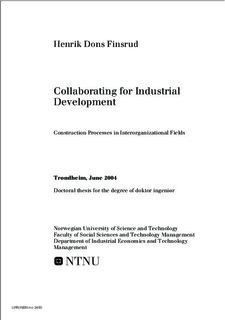| dc.description.abstract | Industrial development at a regional level demands an ability to create productive cross sector collaboration. This thesis is about how such interorganizational collaboration can be constructed. Based on studies of three collaborative efforts taking place in the same region at the same time, I set out to answer the following main research question.
How can regional actors collaborate to support development in enterprises?
In the theoretical part of the thesis, I address the discourses on industrial development with an emphasis on the collaborative aspects. Three approaches that all heavily influence the current thinking and policymaking in this field are discussed. The first is what may be labeled the regional-development orientation associated with industrial districts and flexible specialization after Piore & Sabel (1984), mainly within the discipline of industrial geography. The second main contribution to the discourse on industrial development is the work of Porter (1990) and his followers. Typical for these two main contributions is that they circle around various collaborative constructs at a systemic or macro level (e.g. networks, industrial clusters) and in essence argue for the centrality of interorganizational collaboration in fostering industrial development. What they both lack, however, is considerations of how the desired collaborations can be created, i.e. they lack a development perspective that addresses the collaborative processes essential to practical development.
The third tradition or approach is associated with public planning for development. It takes the public actors as a point of departure in discussing how industrial development may be advanced. Within certain traditions of public planning associated with community development, a much clearer emphasis is put on broad regional participation and concrete means to involve various actors in collaborative planning efforts. I argue that in order to develop industry, a greater emphasis on “how” is needed, and I question the adequacy of a planning logic in this respect.
The broad support for collaborative strategies, but inability to contribute beyond declaring its importance, leads me to the main theoretical chapter where I address the issue of collaboration. Collaboration between organizations is viewed as a general approach to addressing shared problems, where industrial development is one such problem-complex. In conceptualizing collaboration, I give special attention to social ecology (e.g. Trist 1983) as a framework for interorganizational development. Organizing collaborative domains and collaborative processes are the two main foci of the chapter. I criticize the linear process models and develop the interactive dimension of collaborative processes as an alternative. This chapter ends in an expansion of the main research question into the following issues.
1) the organizing of collaboration
2) the processes of collaboration
3) the regional dimension of collaboration
4) the role of public actors
In part three of the thesis I present the case material covering 5+ years of development trajectories. The Joint Project, the Wood Centre and the Electronics Committee all have central features in common. All the three cases address competence development in enterprises, and they do it through collaboration between enterprises, the educational system and country representatives, however in clearly different ways. Moreover, the cases unfold during the same time period in the same country. Theses similarities give special access to the understanding of collaborative development processes by comparing across the cases.
Analysing and discussing the three development trajectories in part four of the thesis lead me to the last chapter, where my conclusions and contributions to the literature are presented. On the issue of organizing, several contributions to collaborative theory have emerged during the research process. I criticize the prevalent sequential and rather mechanistic contributions in the current literature, and I argue for a more dynamic and rather mechanistic contributions in current literature, and I argue for a more dynamic and iterative understanding of organizational issues. In a regional landscape where legitimacy, the building of trust and the development of relationships are at the core of feasible strategies for change, roles, functions and organizational forms need to be understood in a relational and dynamic perspective. This included regarding convening as an ongoing process throughout the lifespan of a collaborative effort, and to understanding the issue of organizing as a process of ongoing reconstruction, rather than a once-and-for-all construction of an organizational unit. As an alternative to the prevailing process models. I have developed principles of interactivity to characterize dynamic and evolving collaborative relationships based on a democratic value stand.
I have developed the regional dimension of collaboration by introducing new concepts (partial domain, sub-domain and triple connectedness), as well as developing the meaning of previously introduced concepts (infrastructure for change). I suggest the concept of a regional infrastructure for change as the conceptual bridge between industrial geography, collaborative theory and an action research oriented approach to industrial development. While the study does not fully discuss the role of public actors, it clearly argues the importance of a proactive role, and discusses some dilemmas with such a role. I emphasise the importance of regional autonomy, the recognition of public-public collaboration a part of industrial development, and the challenge for public actors of moving back and forth between the two different logics associated with, respectively, bureaucracy and horizontal collaboration. | nb_NO |
